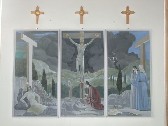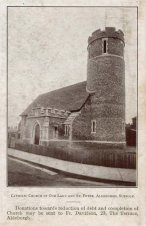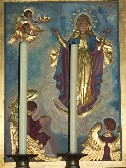| |
|
 |
|
This pretty little
building sits on a hill top in genteel
suburban Aldeburgh, with stunning views
of the coast below. Its flintwork and
fortress-like porch make it rather
familiar in Suffolk, and it enjoys an
apparent High Victorian campness, where
Norman lancets in the apse and
Perpendicular windows in the nave live
together in a jolly proximity. Catholic
priests of Aldeburgh ministered at the
large church of St Peter and St Paul
before the Reformation; but that is
Anglican property now, of course, and the
Catholic presence returned to Aldebugh in
the 1890s. But that was to a temporary
chapel ,and this is not a Victorian
building, at all. its date of about 1920
gives it a Metroland frisson which is
rather thrilling, in a county virtually
devoid of such excitement. The Arts and
Crafts influenced high pitched roof
elevates this building from being merely
amusing to an imaginative liveliness
worthy of this stylish little town. In
fact, it used to look much more
conventional. The elegant coving of the
roof above what appears to be an apse is
not some fancy art deco effect, but an
accident of history, as we shall see. |
Like many Catholic churches
of the 20th Century, Our Lady and St Peter is
still not complete; the wood-panelled north wall
betrays that there were plans for a further
extension. The building is aligned north-south
rather than east-west, and the porch, in
traditional Suffolk late-medieval style, faces
east. As you enter it, the table piled high with
books and leaflets leave no doubt that this is a
Catholic church. But stepping into the nave, you
may be momentarily disorientated. That 'apse' is
to the right, which intuitively should be
liturgically east, and contain the sanctuary; but
it is screened off, for use as a sacristy.
Instead, you turn left to face the altar. The
reason is simple - it is not an apse at all. It
is all that remains of a round tower, one of
Suffolk's few modern ones. When this church was
built, it was intended to be very much in the
style of the 40-odd round towered medieval
churches that you find in the county,
particularly along the coast.
Friend of the site David Whittle sent me
postcards that showed the church in its various
stages of construction; it was built from the
tower southwards, and at one point the south end
consisted of what appears to be a wooden
cottage-style construction. I'm guessing, but I
think it must have been the presbytery. Shortly
after the church was completed, the tower was
damaged by German bombing during WWII, and had to
be taken down. For only a brief while then, this
pleasant town had a rather grand little building
as its Catholic church, but it is still stylish,
I think.
 
Modern chairs face the
Comperish sanctuary with its Flemish-style
reredos under an arched-braced roof, again
traditional in style. The modern stations of the
cross are excellent. A small baptistry leads off
in the south-west corner, and also forms a chapel
of Our Lady of Walsingham.
| Aldeburgh was, of
course, the home of that most Anglican of
20th Century composers, Benjamin Britten.
It is not solely the result of the
Festival which he created that this town
is now second only to Southwold in terms
of the percentage of its houses which are
holiday homes for outsiders, or for the
large number of residents who are also
not from Suffolk. I'm glad that not all
of Suffolk's towns are like that; but the
outsiders, and the Britten influence,
give Aldeburgh a very special character,
and a High Street full of shops which are
absolutely thriving from the visitors who
turn the town into a car park in high
summer. Residents and visitors alike give
the congregation here at Our Lady and St
Peter a character all of its own as well.
The church is in a joint parish with the
church at Leiston a few miles off, and it
is hard to imagine a greater contrast
than between these two very unalike
neighbours. I'm
fond of this finely-crafted building, and
like nothing better than to cross the
quiet road after a visit, walk down the
steps to the high street below, and seek
out one of this lovely town's old inns.
|
|
 |
|
|
|

